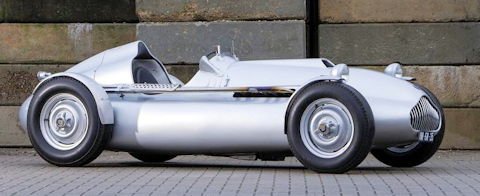Veritas Meteor
 | |
| Overview | |
|---|---|
| Manufacturer | Veritas |
| Production | 1950-1953 |
| Body and chassis | |
| Class | single-seater |
| Powertrain | |
| Engine | 2.0L Six Cylinder |
| Transmission | five-speed gearbox |
In 1949, under the designer Ernst Loof, the Veritas Meteor, a single-seater with free-standing wheels corresponding to the then valid Formula 2 , after 1952 and 1953, the races were held for the World Automobile Championship. Approved were racing cars with up to 500 cc and compressor or with a maximum of 2000 cc displacement without compressor.
The basis of Heinkel's engine in the Veritas Meteor was the six-cylinder engine of the BMW 328, which was further developed by former BMW employees Karl Schäfer, Karl Rech and Max Knoch. The eye-catching feature of the new inline engine with a displacement of 1988 cc was the overhead camshaft, which controlled the V-shaped hanging in the cylinder head valves. The crankshaft ran in lead-bronze bearings, while the connecting rods were roller-bearing both on the crank pin and on the piston pin. The engine made 140 hp at 7000 min; it was water-cooled with 10 liters of water in circulation and had dry sump lubrication with a capacity of 12 liters.
The power was transmitted via a single-disc dry clutch, a five-speed gearbox with a special oil pump and a cardan shaft to a self-locking differential gear or to the rear wheels. Depending on the racetrack, the gears of the differential could be changed to adjust the ratio.
The frame of the Veritas Meteor consisted of a pipe grid ( grid frame ). The front wheels were hung on double wishbones, with each a longitudinal torsion spring bar acted on the upper handlebars and the oblique telescopic shock absorbers were supported on the lower arms. The likewise torsstabfedered rear double-jointed axle had on each side of a wishbone and in addition a wishbone on the differential and from 1952 a De-Dion support tube behind the differential.
The foot brake worked hydraulically on four light metal drums via two brake cylinders. The car was driven either with steel disc wheels or with Rudge steel spoke wheels, both versions with central locks.
By order of the racing driver Karl Kling , the body shop Hebmüller built 1950 a streamlined body for a Veritas Meteor. Kling won the solitary race by car on August 13 of the same year. In 1951, Kling passed on the car to Hans Klenk, who also had a normal racing car body (with free-standing wheels) made for slow and agile courses the following year. In this variant, Hans Herrmann started on 2 August 1953 at the Grand Prix of Germany on the Nürburgring. Another streamline body was made at Veritas at the Nürburgring for the Meteor by Paul Pietsch. In contrast to the Hebmüller body this had a closed cockpit and could be mounted on demand on the existing racing car body. Pietsch wanted to go to the start of the Avus race in 1952, but had a serious accident in training, in which the car was badly damaged.
Rating
Technical
-
Specifications
Characteristics meteor RS Comet Comet S. Saturn Scorpion body monoposto Roadster, 2 doors,
2 seatsCoupé, 2 doors,
2 seats
(body Spohn, Ravensburg)Coupé, 2 doors, 2 + 2 seats
(body Spohn,
Ravensburg)Cabriolet, 2 doors,
2 + 2 seats
(body Spohn,
Ravensburg)engine 6-cylinder in-line engine motor control an overhead camshaft a lateral camshaft an overhead camshaft capacity 1988 cm³ 1971 cm³ 1988 cm³ Bore × stroke 75 × 75 mm 66 × 96 mm 75 × 75 mm compression ratio 12: 1 7.5: 1 8: 1 6.5: 1 7.2: 1 carburettor 3 Solex API 40 3 Solex 40 JF 1 downdraft carburetor Solex 3 Downstream gasifier Solex PBI 32 power 140 hp (103 kW) at 7000 rpm 115 hp (85 kW) at 6000 rpm 80 hp (59 kW) at 5000 rpm 55 hp (40 kW) at 4200 rpm 100 hp (74 kW) at 5000 rpm transmission 5-speed
(4 gears synchronized)4-speed fully synchronized 5-speed (4 gears synchronized) frame pipe grid - - - - Front suspension Double wishbone wishbone double wishbones Rear suspension Wishbone and
De-Dion support tubeStarrachse De Dion tube suspension longitudinal torsion bars front transverse leaf spring, rear Halbelliptikfedern Spring bars in the longitudinal direction shock absorber hydraulic brakes Drum brake, Ø 300 mm hydraulic four-wheel drum brakes hydraulic light metal drum brakes with dual-circuit system layer width 50 mm - - - - - wheel size front 5.50 × 16 ",
rear 6.00 × 16"5.50 × 16 " Length × width × height 3370 × 1550 × 1050 mm 4000 × 1515 × 1100 mm
(without hood)4200 × 1515 × 1380 mm 4250 × 1515 × 1350 mm wheelbase 2250 mm 2500 mm 2600 mm gauge front 1280 mm, rear 1300 mm front 1180 mm, rear 1220 mm, front 1308, rear 1300 mm turning circle 12.5 m 11 m 12.5 m tare 560 kg 1000 kg 1300 kg 1100 kg top speed up to 240 km / h 160 km / h 180 km / h 149 km / h 160 km / h



